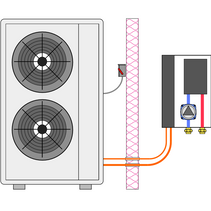Available Training

What is Hydronic Heating?
Hydronic heating systems use water to move heat from where it is produced to where it is needed. The water within the system is neither the source of the heat nor its destination; only its "conveyor belt." Heat is absorbed by the water at a heat source, conveyed by the water through the distribution piping, and finally released into a heated space by a heat emitter.
Modern hydronics technology enables heat to be delivered precisely when and where it is needed. Hundreds of system configurations are possible, each capable of meeting the exact comfort requirements of its owner. Some may be as simple as a tank-type water heater connected to a loop of flexible plastic tubing for warming a bathroom floor. Others may use two or more boilers operated in stages, releasing their heat through an assortment of heat emitters. The same boiler(s) may also provide the building's domestic hot water. They might even heat the swimming pool, or melt snow as it falls on the driveway. Well- designed and properly installed hydronic systems provide unsurpassed comfort and fuel efficiency for the life of the building.
The Benefits of Hydronic Heating

Providing comfort should be the primary objective of any heating system designer or installer. Unfortunately, this objective is too often compromised by other factors, the most common of which is cost. Even small residential heating systems effect the health, productivity, and general contentment of several people for many years. It only makes sense to plan and install them accordingly.
The average building owner doesn't spend much time thinking about the consequences of the heating system they select. Many view such systems as a necessary but uninteresting part of a building. When construction budgets are tightened, it's often the heating system that's compromised to save money for other, more impressive amenities.
Heating professionals should take the time to discuss comfort as well as price with their clients before decisions on system type are made. Often people who have lived with uncomfortable heating systems simply don't realize what they have been missing. In retrospect, many would welcome the opportunity to have truly comfortable buildings, and would willingly spend more money (if necessary), to achieve it.
Maintaining comfort is not a matter of supplying heat to the body. Instead, it's a matter of controlling how the body loses heat. When interior conditions allows heat to leave a person's body at the same rate it is generated, that person feels comfortable. If heat is released faster or slower than the rate it's produced, some degree of discomfort is felt.
The interior environment significantly effects the processes by which the body loses heat. For example, most people will not be comfortable in a room containing many cool surfaces such as large windows, even if the room's air temperature is 70 ºF. For optimum comfort, the interior environment must provide the proper balance of air temperature, average surface temperature, and relative humidity to accommodate the various processes through which the body releases heat.
Properly designed hydronic systems control both the air temperature and surface temperatures of rooms to maintain optimal comfort. Hydronic heat emitters such as radiant floors or ceilings raise the average surface temperature of rooms. Since the human body is especially responsive to radiant heat loss, these heat emitters significantly enhance comfort. Comfortable humidity levels are also easier to maintain in hydronically-heated buildings.
Several factors such as activity level, age, and general health determine what is a comfortable environment for a given individual. When several people are living or working in a common environment, any one of them might feel too hot, too cold, or just right. Heating systems that allow various "zones" of a building to be maintained at different temperatures can adapt to the comfort needs of several individuals. Although both forced-air and hydronic heating systems can be zoned, the latter is usually much simpler and easier to control.












